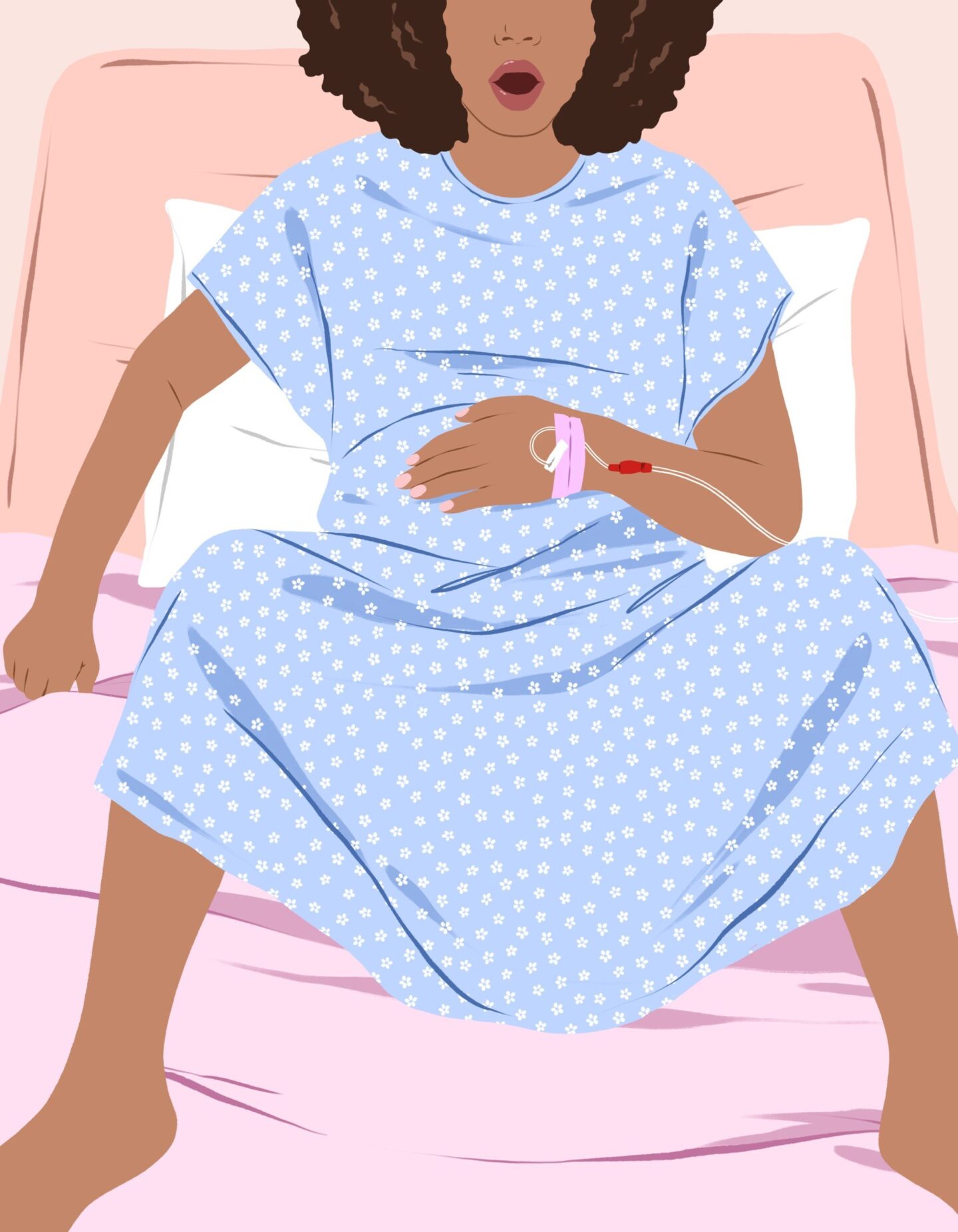No one likes the aches and pains that present themselves during pregnancy. We’ve found that it’s helpful to know where they are coming from and the cause in case there are ways to help minimize the pain or prevent them altogether.
If you notice pain in your lower back and thigh region, it could be pregnancy-related pelvic girdle pain. Back pain, along with any form of pain, can be exhausting, especially while pregnant. You already have so many things on your to-do list, and back pain is certainly not as fun as decorating a nursery or shopping for the perfect maternity swimsuit.
Let’s talk about pelvic pain in pregnancy and how to manage it.
What Is Pelvic Girdle Pain?
You might know pelvic girdle pain or PGP by another term: symphysis pubis dysfunction or SPD.
PGP is caused by stiffness of the pelvic joints or the joints unevenly moving at the back or front of the pelvis. This condition affects around one in five pregnant women. The pelvic area has a lot of extra pressure while carrying a baby, the placenta, and excess fluids.
With that added pressure, you may notice symptoms of PGP, including:
- Difficulty walking
- Pain from weight bearing on one leg when climbing stairs
- Pain when making straddling movements (getting in and out of the bath)
- Clicking or grinding in the pelvic area (specifically your perineum)
- Pain when lying in some positions
- Pain/difficulty during sex
- Pain during normal daily activities
What Causes Pelvic Girdle Pain?
Pelvic girdle pain can fluctuate throughout pregnancy but can significantly increase as your pregnancy progresses and your baby gets bigger. There are many possible causes of pelvic girdle pain during pregnancy. One known cause of PGP is the hormone relaxin. This hormone, produced by your ovaries and placenta, helps prepare your body for childbirth.
Relaxin, which is highest during the first trimester, softens and widens your cervix and relaxes your pelvic ligaments. This can cause pelvic floor pain, especially if you have a history of low back pain, trauma to your back or pelvis, poor muscle function, pubic symphysis rupture, or hypermobility syndrome.
If you have any of these PGP symptoms, make sure to alert your healthcare provider at your next appointment.
What Are the Effects of Pelvic Girdle Pain?
Pelvic girdle pain is affecting pregnant women all across the world. It is common to experience some form of it at some point in your pregnancy. The pain you’re feeling can originate from your sacroiliac joints and your symphysis pubis joints.
These pelvic joints are connected to your pubic bones, which might be where you notice the pain starting. Pregnant women may also experience lumbar pain. Ugh. We really need to catch a break here.
Luckily, PGP won’t affect your growing baby. However, it can affect many everyday activities, including getting out of the car and having sex. Activities you usually enjoy, like prenatal yoga and walking to Starbucks with your bestie, now seem like more trouble than they’re worth.
Ready for some good-ish news? PGP is unlikely to affect your labor and delivery and will probably go away after your baby is born. 83% of new moms were happy to report that their PGP pain improved after giving birth. Note that some cases do continue into the fourth trimester. If that’s the case, call your doc and make an appointment.
In the meantime, there are plenty of ways to lessen the pain and improve your comfort level.
How To Improve Your Quality of Life With Pelvic Girdle Pain
Although pelvic girdle pain is not the ideal way to spend your nine months, there are ways to support your body to help lessen the pain or prevent its symptoms altogether.
If you are annoyed by pelvic girdle pain during your pregnancy, here are some at-home tips for pelvic pain relief:
Improve Your Posture
Some of the lumbopelvic pain you could be experiencing can be rooted in poor posture. One way you can fix this is by consistently correcting your posture when you notice slouching (hello 2 PM Zoom call meetings). This is a habit you can continue practicing postpartum.
Having good lower back support when sitting is a great way to keep back pain to a minimum. Interestingly, crossing your legs while sitting is not part of good posture practices. This can be a hard habit to unlearn as a woman, especially since all the would-be charm school instructors started nagging us about this from day one.
Another way to avoid putting unnecessary pressure on your pelvic area is by placing a supportive pregnancy pillow between your knees and legs at night while you sleep on your side. A regular pillow will do the job in a pinch. Grab your favorite maternity pajamas, a pillow, and a good book — it’s time for some sweet dreams.
Adjust Your Everyday Activities
Just like with uncrossing your legs, there are potentially small things you do every day that could be contributing to your pelvic girdle pain:
Let’s look at the hidden-in-plain sight activities that might be the culprit behind the ouch:
Ask for Help With Chores
Grocery shopping is necessary; however, walking around a store for an hour while pushing a heavy cart is not. Online shopping is a blessing to pregnant women experiencing pelvic girdle pain. If that doesn’t fit the bill, try handing your shopping list to a partner or friend you can count on to know which kind of almond milk you like the best.
Avoid lifting heavy objects; this can reduce the chance of injury and potential pelvic pain. When setting up your baby’s nursery, have someone help move those heavier objects like furniture.
It’s tempting to just climb the stairs like normal despite what your breathing may sound like. When pregnant, especially with pelvic girdle pain, it’s best to take one stair at a time. You know the saying, “One small step for pregnant ladies, one giant leap for the future of mankind”… or something like that.
Be Mindful Around Movement
It’s best not to keep your body in the same sitting or standing position for too long. Take as many breaks as you need and listen to your body. If you notice you’re starting to feel sore after a while of being on your feet, take time to rest.
If you have pain or clicking sounds when getting in and out of your car, try keeping your legs together when moving them. This is to avoid that outward movement your hips usually make when getting out of your car.
If you have smaller children who like to be held, try sitting first and inviting them to sit on your lap instead. Picking them up or carrying them on your hip for long periods can put extra pressure on your pelvic bones, which is not the vibe you’re looking for.
Exercising is great for your body and overall mental health. Walking is a safe and easy approach to exercise, especially in your later months of pregnancy. If walking isn’t your preference, you might enjoy low-impact exercise. Throw on your trusty leggings and take it one step at a time.
Possible Treatments for PGP
If you notice that these small, easy adjustments are not making an overall impact on your symptoms of pelvic girdle pain, here are some things to consider with your doctor:
Physiotherapy
Physiotherapy is a great option if PGP is on your list of complaints.
A women’s health physiotherapist or physical therapist will first evaluate you to determine the condition of your pelvic floor, joints, pelvic floor muscles, and surrounding areas. They will then make a professional plan on what exercises, therapies, and activities could be the most soothing. If you are on your feet a lot or like walking but find it painful, your physiotherapist or obstetrician may also suggest wearing a pelvic support belt.
Medications
The health professional in your life might want to try medications like paracetamol, ibuprofen, or Tylenol.
Alternative Medicine
Chiropractors could possibly help soothe symptoms of PGP. Some potential techniques might involve ligament releases as well as diaphragmatic releases. Trained chiropractors can also perform pubic bone adjustments, work on soft tissues, and more.
In addition to physical therapy (gynecological physiotherapy), you may find relief from manual therapy treatments like acupuncture and massage.
Get Comfortable
Doing what you can to find relief from pelvic girdle pain will help your days tremendously. These were just a few different ways to make adjustments that could make you feel better overall.
In the meantime, be gentle with yourself. Take a bath, read a book, and eat that ice cream cone. And when your little baby grows into a teenager, you can remind them of what you did for them every time they miss curfew.
Sources:








